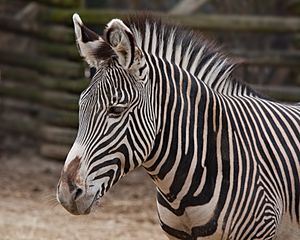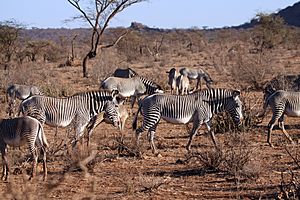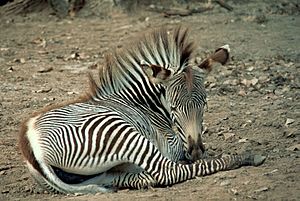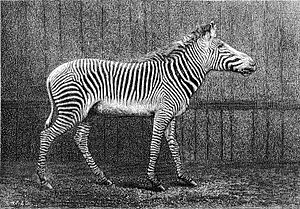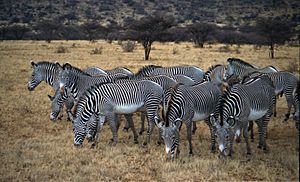Grévy's zebra facts for kids
Quick facts for kids Grévy's zebra |
|
|---|---|
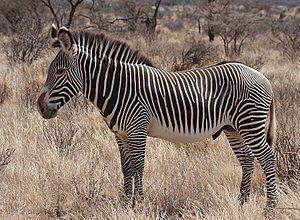 |
|
| A Grévy's zebra at Buffalo Springs National Reserve. | |
| Conservation status | |
| Scientific classification | |
| Genus: |
Equus
|
| Species: |
grevyi
|
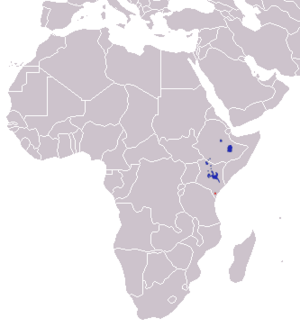 |
|
| Grévy's zebra range native introduced |
|
The Grévy's zebra (Equus grevyi), also known as the imperial zebra, is the largest living wild equid and the most threatened of the three species of zebra, the other two being the plains zebra and the mountain zebra. Named after Jules Grévy, it is found in Kenya and Ethiopia. Compared with other zebras, it is tall, has large ears, and its stripes are narrower.
The Grévy's zebra lives in semi-arid grasslands where it feeds on grasses, legumes, and browse; it can survive up to five days without water. It differs from the other zebra species in that it does not live in harems and has few long-lasting social bonds. Stallion territoriality and mother–foal relationships form the basis of the social system of the Grévy's zebra. This zebra is considered to be endangered. Its population has declined from 15,000 to 3,000 since the 1970s. In 2008 the population was reported to be stable.
Contents
Taxonomy and naming
The Grévy's zebra was first described by French naturalist Émile Oustalet in 1882. He named it after Jules Grévy, then president of France, who, in the 1880s, was given one by the government of Abyssinia. Traditionally, this species was classified in the subgenus Dolichohippus with plains zebra and mountain zebra in Hippotigris. Groves and Bell (2004) place all three species in the subgenus Hippotigris.
Fossils of zebra-like equids have been found throughout Africa and Asia in the Pliocene and Pleistocene deposits. Notable examples include E. sanmeniensis from China, E. cautleyi from India, E. valeriani from central Asia and E. oldowayensis from East Africa. The latter, in particular is very similar to the Grévy's zebra and may have been its ancestor. The modern Grévy's zebra arose in the early Pleistocene. Zebras appear to be a monophyletic lineage and recent (2013) phylogenies have placed Grevy's zebra in a sister taxon with the plains zebra. In areas where Grévy's zebras are sympatric with plains zebras, the two may gather in same herds and fertile hybrids do occur.
Description
The Grévy's zebra is the largest of all wild equines. It is 2.5–2.75 m (8.2–9.0 ft) in head-body with a 55–75 cm (22–30 in) tail, and stands 1.45–1.6 m (4.8–5.2 ft) high at the withers. These zebras weigh 350–450 kg (770–990 lb). Grévy's zebra differs from the other two zebras in its more primitive characteristics. It is particularly mule-like in appearance; the head is large, long, and narrow with elongated nostril openings; the ears are very large, rounded, and conical and the neck is short but thick. The zebra's muzzle is ash-grey to black in colour with the lips having whiskers. The mane is tall and erect; juveniles have a mane that extends to the length of the back and shortens as they reach adulthood.
As with all zebra species, the Grevy's zebra's pelage has a black and white striping pattern. The stripes are narrow and close-set, being broader on the neck, and they extend to the hooves. The belly and the area around the base of the tail lack stripes and are just white in color, which is unique to the Grevy's zebra. Due to the stripes being closer together and thinner than most of the other zebras, it is easier for them to make a good escape and to hide from predators. Foals are born with brown and white striping, with the brown stripes darkening as they grow older. Embryological evidence has shown that the zebra's background colour is dark and the white is an addition. The stripes of the zebra may serve to make it look bigger than it actually is or disrupt its outline. It appears that a stationary zebra can be inconspicuous at night or in shade. Experiments have suggested that the stripes polarize light in such a way that it discourages biting horse-flies in a manner not shown with other coat patterns. Other studies suggest that, when moving, the stripes may confuse observers, such as mammalian predators and biting insects, via two visual illusions, the wagon wheel effect, where the perceived motion is inverted, and the barber pole illusion, where the perceived motion is in a wrong direction.
Range and ecology
The Grévy's zebra largely inhabits northern Kenya, with some isolated populations in Ethiopia. It was extirpated from Somalia and Djibouti and its status in South Sudan is uncertain. It lives in Acacia-Commiphora bushlands and barren plains. Ecologically, this species is intermediate between the arid-living African wild ass and the water-dependent plains zebra. Lactating mares and non-territorial stallions use areas with green, short grass and medium, dense bush more often than non-lactating mares and territorial stallions.
Grévy's zebras rely on grasses, legumes, and browse for nutrition. They commonly browse when grasses are not plentiful. Their hindgut fermentation digestive system allows them to subsist on diets of lower nutritional quality than that necessary for ruminant herbivores. Grevy's zebras can survive up to a week without water, but will drink daily when it is plentiful. They often migrate to better watered highlands during the dry season. Mares require significantly more water when they are lactating. During droughts, the zebras will dig water holes and defend them. The grévy's zebras main predator is the lion, but adults can be hunted by spotted hyenas. African hunting dogs, cheetahs and leopards almost never attack adults, even in desperate times, but sometimes prey on young animals, although mares are fiercely protective of their young. In addition, they are susceptible to various gastro-intestinal parasites, notably of the genus Trichostrongylus.
Behaviour and life history
Adult stallions mostly live in territories during the wet seasons but some may stay in them year round if there's enough water left. Stallions that are unable to establish territories are free-ranging and are known as bachelors. Mares, young and non-territorial stallions wander through large home ranges. The mares will wander from territory to territory preferring the ones with the highest-quality food and water sources. Up to nine stallions may compete for a mare outside of a territory. Territorial stallions will tolerate other stallions who wander in their territory. However, when an oestrous mare is present the territorial stallion keeps other stallions at bay. Non-territorial stallions might avoid territorial ones because of harassment. When mares are not around, a territorial stallion will seek the company of other stallions. The stallion shows his dominance with an arched neck and a high-stepping gait and the least dominant stallions submit by extending their tail, lowering their heads and nuzzling their superior's chest or groin.
Zebras produce numerous sounds and vocalisations. When alarmed, they produce deep, hoarse grunts. Whistles and squeals are also made when alarmed, during fights, when scared or in pain. Snorts may be produced when scared or as a warning. A stallion will bray in defense of his territory, when driving mares, or keeping other stallions at bay. Barks may be made during copulation and distressed foals will squeal. The call of the Grévy's zebra has been described as "something like a hippo's grunt combined with a donkey's wheeze". To get rid of flies or parasites, they roll in dust, water or mud or, in the case of flies, they twitch their skin. They also rub against trees, rocks and other objects to get rid of irritations such as itchy skin, hair or parasites. Although Grévy's zebras do not perform mutual grooming, they do sometimes rub against a conspecific.
Reproduction
Gestation of the Grévy's zebra normally lasts 390 days, with a single foal being born. A new-born zebra will follow anything that moves, so new mothers prevent other mares from approaching their foals while imprinting their own striping pattern, scent and vocalisation on them. Mares with young foals may gather into small groups. Mares may leave their foals in "kindergartens" while searching for water. The foals will not hide, so they can be vulnerable to predators. However, kindergartens tend to be protected by an adult, usually a territorial stallion. A mare with a foal stays with one dominant territorial stallion who has exclusive mating rights to her. While the foal may not be his, the stallion will look after it to ensure that the mare stays in his territory. To adapt to a semi-arid environment, Grévy's zebra foals have longer nursing intervals and wait until they are three months old before they start drinking water. Although offspring become less dependent on their mothers after half a year, associations with them continue for up to three years.
Relationship with humans
The Grévy's zebra was known to the Europeans in antiquity and was used by the Romans in circuses. It was subsequently forgotten in the Western world for a thousand years. In the seventeenth century, the king of Shoa (now central Ethiopia) exported two zebras; one to the Sultan of Turkey and another to the Dutch governor of Jakarta. A century later, in 1882, the government of Abyssinia sent one to French president Jules Grévy. It was at that time that the animal was recognised as its own species and named in Grévy's honour.
Status and conservation
The Grévy's zebra is considered endangered. Its population was estimated to be 15,000 in the 1970s and by the early 21st century the population was lower than 3,500, a 75% decline. It is estimated that there are less than 2,500 Grévy's zebras still living in the wild. There are also an estimated 600 Grévy's zebras in captivity. Captive herds have been known to thrive, like at White Oak Conservation in Yulee, Florida, United States, where more than 70 foals have been born. There, research is underway in partnership with the Conservation Centers for Species Survival on semen collection and freezing and on artificial insemination. The Grévy's zebra population trend is considered stable as of 2008.
The Grévy's zebra is legally protected in Ethiopia. In Kenya, it is protected by the hunting ban of 1977. In the past, Grévy's zebras were threatened mainly by hunting for their skins which fetched a high price on the world market. However, hunting has declined and the main threat to the zebra is habitat loss and competition with livestock. Cattle gather around watering holes and the Grévy's zebras are fenced from those areas. Community-based conservation efforts have shown to be the most effective in preserving Grévy's zebras and their habitat. Less than 0.5% of the range of the Grévy's zebra is in protected areas. In Ethiopia, the protected areas include Alledeghi Wildlife Reserve, Yabelo Wildlife Sanctuary, Borana Controlled Hunting Area and Chelbi Sanctuary. In Kenya, important protected areas include the Buffalo Springs, Samburu and Shaba National Reserves and the private and community land wildlife conservancies in Isiolo, Samburu and the Laikipia Plateau.
The mesquite plant was introduced into Ethiopia around 1997 and is endangering the zebra's food supply. An invasive species, it is replacing the two grass species, Cenchrus ciliaris and Chrysopogon plumulosus, which the zebras eat for most of their food.
See also
 In Spanish: Equus grevyi para niños
In Spanish: Equus grevyi para niños



